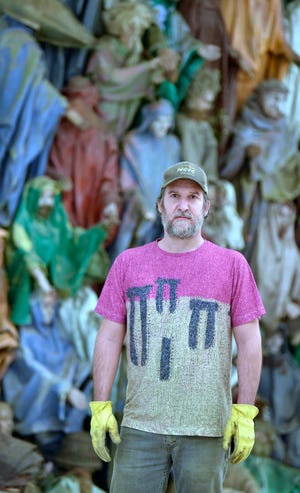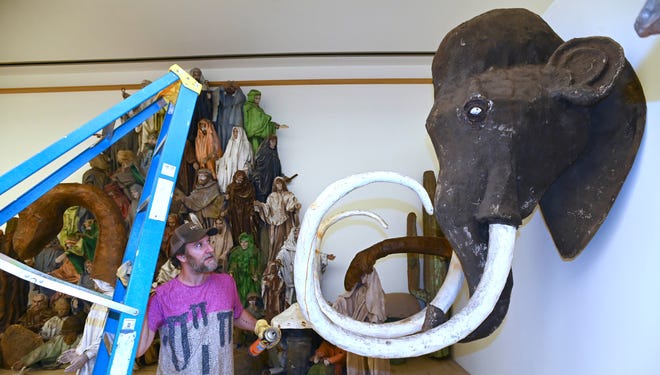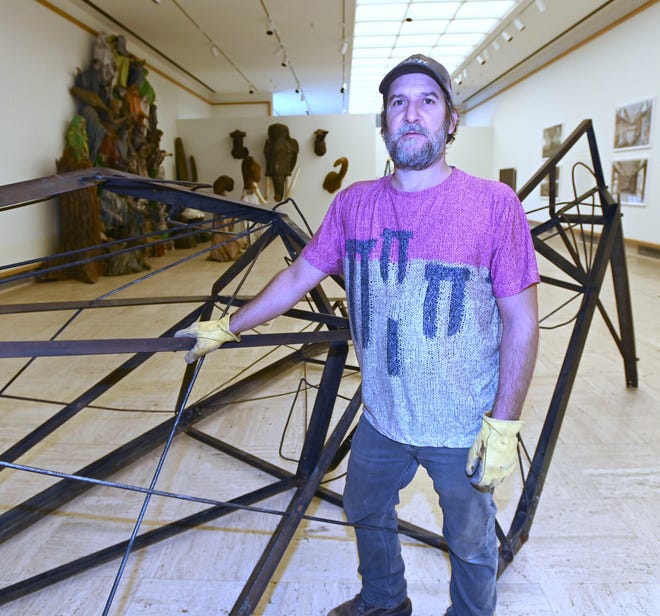Scott Hocking leads trio of Detroit artists in new Cranbrook exhibit
Scott Hocking leads trio of Detroit artists in new Cranbrook exhibit
Original Article via Detroit News, posted on Nov. 4, 2022
Detroit’s arts scene will be in the spotlight beginning Saturday with a series of exhibitions of powerful displays that include larger-than-life-sculptures, vibrant mixed-media paintings and hyper-realistic still lifes.

The Cranbrook Art Museum is showcasing some of Detroit’s best artists, led by a retrospective of work by sculptor and photographer Scott Hocking. Joined by painters James Benjamin Franklin and Bakpak Durden, the exhibit shares the works of local artists at varying stages of their careers.
Andrew Satake Blauvelt, director of Cranbrook Art Museum, said the artists reflect the richness of Detroit’s artistic scene with perspectives that range from witnessing first-hand changes of the city over decades, to a southern California transplant bringing an outside perspective, to a self-taught artist who was born and raised in Detroit.
“Each artist’s approach to art and their individual backgrounds is utterly unique and that reflects the diversity of the city’s art scene: there’s no single ‘Detroit’ look, there are only multitudes,” he said.

The centerpiece of the exhibition is “Scott Hocking: Detroit Stories,” representing 25 years of the artist’s work that document the city’s history and change. Hocking is known for his sculptures made from repurposed existing materials and found objects, many from Detroit’s abandoned buildings and built on site, which are now presented in photos.
His most famous sculptures include a giant egg inside Michigan Central Station made from hundreds of pieces of slab marble debris from inside the building and a massive ziggurat structure built inside the Fisher Body Plant created from thousands of wooden floor blocks. Another project involved collecting a series of abandoned boats found throughout Detroit and hanging them for an arrangement inside an abandoned building.
“Scott’s work is really about post-industrial Detroit, that’s why a lot of that has been changing…,” Blauvelt said. “The Detroit of 1999 is not the Detroit of 2022, a lot of this ends up being an archive of the history of the city, which we find really interesting.”
One of Hocking’s most dramatic works is RELICS, a series of 18-inch square wooden boxes featuring found objects throughout Detroit. Started in 2001 in collaboration with Clint Snyder, the project has evolved over the years, documenting Detroit’s history. The latest version of the installation at Cranbrook features 200 boxes that cover an entire wall, filling the space with abandoned signs, toys, keys, tools, tiles, bottles, pipes and more in neat rows.

“It’s a future artifact installation,” Hocking said. “It’s kind of playing with the idea of, ‘What are our artifacts?’ ‘What are the artifacts we produce now?’ ‘How will we be perceived in the future?’ ‘How do we perceive people in the past?’ It’s kind of juxtaposing all those thoughts.”
“James Benjamin Franklin: Full Circle” features a colorful series of roughly 61/2-square-feet of paintings. Franklin, a southern California native and a 2017 graduate of the Cranbrook Academy of Art, paints layers of found textiles — like blankets, carpets, rugs and bathmats — onto a base of plaster and foam, occasionally dusted with glitter or sand.
“There’s a lot of handcrafted-ness going on, which is really a big kind of moment in contemporary art,” Blauvelt said.

Franklin said he hopes the viewer gets a sense of what the human spirit can create.
“(I want them to) get lost and get a sense of either joy or mystery in the work and all the materials that are used,” he said, “and just kind of all the things that are unexpected and surprising.”
“Bakpak Durden: The Eye of Horus” is the final exhibit of the series. It draws its name from an ancient Egyptian symbol and concept thought to have healing powers and was also used in ancient mathematical and neurological contexts. Durden is a self-taught artist whose hyper-realistic work is reminiscent of Dutch Baroque painting and dramatic cinema.

While the exhibit includes a series of Durden’s self-portraits, its focal point is “Khemia” — an ancient term for Egypt — and the basis for concepts of alchemy and a progression to chemistry.
“We’re going from past to present to future, from physical land as an entity to the body as revitalization,” Durden said. “It’s a linear continuum, circuitous reference to an improvement of self.”
The primary subject of “Khemia” is “Double Crown of the Distant One,” a still life depicting a skull atop of a pile of various objects. Immediately across the painting is the “brain,” a structure dangling 22 smaller canvases — representing the 22 pieces of the skull — depicting different aspects of the original painting. Beyond that is another painting illustrating the back of an eye with a tiny representation inside of an upside-down reflection of “Double Crown of the Distant One,” mimicking how the brain perceives vision.

“(The exhibit) is about the physicality of vision and the brain and also your emotional self,” said Laura Mott, chief curator of Cranbrook Art Museum. “It’s your physical self and your emotional self and bringing those together.”
For the exhibition overall, Hocking said he’s happy to be recognized and to show his work with Franklin and Durden.
“The work looks wonderful in the exhibition,” he said. “I just think it’s a really well-curated show.”

‘Scott Hocking: Detroit Stories’
39221 Woodward, Bloomfield Hills
Cranbrook Art Museum
Saturday-March 19, 2023
More information: Visit www.cranbrookartmuseum.org
The post Detroit News // Scott Hocking leads trio of Detroit artists in new Cranbrook exhibit appeared first on PLAYGROUND DETROIT.
